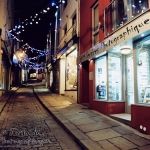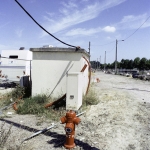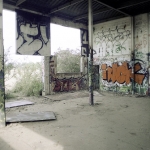Cine film for stills, Nik & Trick's Own Films
Kodak Motion Picture Films – Our Vision!
Researching these you’ll find the word REMJET thrown up as if it were a horror story – a total blockade in terms of moving forwards. It’s as frustrating now looking back as it was then!
Kodak describe Vision films as the best they’ve ever made so it didn’t seem fair that the movie industry should have the monopoly…after all, it’s 35mm film!
We were put off by the word Remjet too…initially it looked like the only way to remove it was in the massive machines at Mothership Kodak. Machines that process 1000ft (305m) at a time using dedicated ECN2 chemistry and machines that literally polish the Remjet layer away.
So we put it to one side….couldn’t help but think though….and one way and another various homemade methods of Remjet removal began to turn up, so when we were offered a can of out of date Vision 2 250D…we thought, as we often do…”We’ll take a punt” 400ft of film is more than plenty to be experimenting with!
Before we continue, we want to make clear that remjet removal is really nothing to worry about.…there are, as we have said, many scare stories out there on the web and we advise that you don’t listen to them!
We have tweaked mixtures and have our own formula, home developers worldwide have their own and there are many out there. With each purchase we include a “cheat sheet” detailing our recommended procedure.
So we shot our first test roll…incredibly dark results, was this to do with Remjet? Eventually we found that it was actually because the film was so out of date it had slowed down so after three rolls we found that it responded to 125asa instead of the original 250. However, it revealed a beautifully detailed film bursting with natural colours, good contrast and a very nice grain structure.
Anybody would have been pleased with that but there was detritus, lots of it. Particles all over and occasional big lumps of remjet still there. Happy, but not something we could offer to retail.
Persistence and tweaking…we must be good theorists! With a few “common sense” (we thought) tweaks we were confident enough that we could process Vision films to a standard of cleanliness that we could begin to offer the first rolls to regular customers. Phew.
[fusion_builder_container hundred_percent=”yes” overflow=”visible”][fusion_builder_row][fusion_builder_column type=”1_1″ background_position=”left top” background_color=”” border_size=”” border_color=”” border_style=”solid” spacing=”yes” background_image=”” background_repeat=”no-repeat” padding=”” margin_top=”0px” margin_bottom=”0px” class=”” id=”” animation_type=”” animation_speed=”0.3″ animation_direction=”left” hide_on_mobile=”no” center_content=”no” min_height=”none”]That’s it? Nope. We were contacted by Panavision and offered some new old stock Vision 2 50D…already we’d been told that the 50asa Visions were exceptional so we snapped it up!
The remjet on this fresher film stock proved problematical…much harder to get off. But what a bit of film! So, more tweaks, changes and additions soon cleared that up and customers who used this film were amazed but it’s amazing detail, outstanding natural colours, reds that popped and almost no perceptible grain. Some compared it to transparency films even the late lamented Kodachrome!
Those two 400ft cans were worth their weight in gold, for us in terms of learning to deal with these films to offer to customers. To customers, to get to use something uncommon in the stills market, to take photos that look like a frame out of a movie…to not have to fret about shooting in daylight or direct or strong light as is the case with Cinestill films.
Having mentioned Cinestill, who remove remjet then spool for shooting, this is a good time to ask; what is Remjet, why is it there, what does it do?
Remjet is a high carbon particulate layer that serves to protect film as it travels through the harsh internal environment of a cinematic camera at some 35fps!
It is so dark that it prevents light contamination from one frame to another via refraction within the base of the film itself and shutter overflow – a extremely effective anti-halation layer, hence the issues with shooting Cinestill…
It also has anti-magnetic and anti-static properties to prevent dust accumulation and static discharge that can occur on transport though camera and cause fogging….to which end it also has some lubricating properties too!
Phew…got that? It’s only really the anti-halation and anti-static that are relevant to us in still photography but none the less, a tough film.
So where are we at now?
Well, after running some special offers and giveaway competitions, the Vision 2 stocks are gone now…folk have confidence to buy and use Vision films knowing that we can process it to a more than satisfactory standard or with research and a bit of trial and error..they can process it at home in C41 chemistry and get fantastic results.
In short, Remjet is nothing to be scared of, it just takes a little extra effort…effort not being something film photographers are afraid of!
It means that we are now acquiring and spooling Vision 3 in 50D and 250D versions. The 50D being the most amazing colour film as per Kodak’s boasts. We can get as much of this stock as needed…its current and made by the mile by Eastman for the motion picture industry where there is also some great revival of film…in fact the new Star Wars film is currently being filmed on the exact same stock…our suppliers won’t say but we are aimed toward that being the source of our can of excess stock 50D…but we’re not allowed to know for sure!
Processing is 99.7% there when it comes to Remjet removal, probably about as good as Kodak’s but minus the mechanical buffing…which really as good as it gets then.
Costs: Cheap. We offer these from £4.40 for 36 exposure roll, a £3.10 saving over Cinestill. We surcharge just £1.50 on top of developing price to account for remjet removal so all in all very economical by comparison to other films of equivalent quality.
Ultimately, we want this to give you the confidence to try some of our Vision film, to not fret about processing and to know that you’re doing something that not so many do as matter of routine. It might even inspire you…?
Tips:
It is great for long exposures and low light conditions
It is very responsive to different types of light ie tungsten & other artificial light sources
Works lovely in bright sun with a polariser – skies look amazing
Kodak Vision films are available from our online shop here: https://ntphotoworks.com/shop/product-category/rare-colour-films/
Thanks for stopping by 🙂
Read our follow-up post “Episode II” by clicking HERE[/fusion_builder_column][/fusion_builder_row][/fusion_builder_container]








